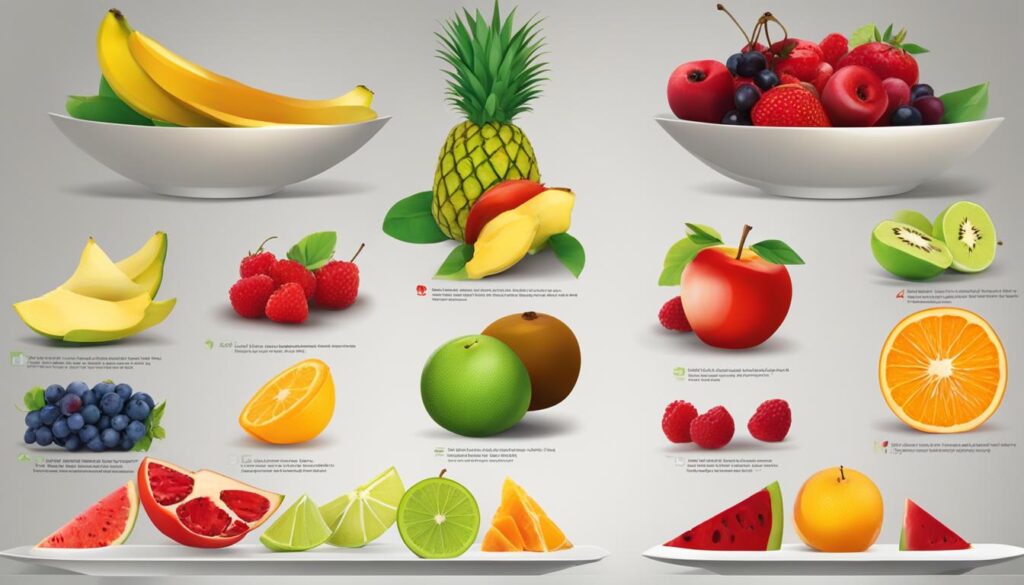What is the Recommended Serving Size of Fruit: When it comes to incorporating fruits into our diet, many of us wonder about the ideal serving size. It’s important to understand that the recommended serving size of fruit can vary depending on factors such as the type of fruit and individual characteristics like age, sex, weight, and physical activity level.

In general, the guideline for a serving of fruit is approximately one cup of raw or cooked fruits, half a cup of dried fruit, or one cup of 100% fruit juice. However, it’s worth noting that these serving sizes are not indications of how much fruit we should eat but rather a helpful guide to ensure we are incorporating enough fruits into our diet to reap their nutritional benefits.
Different fruits have different serving sizes as per fruit portion control recommendations. For instance, one serving of fruit can be equivalent to one small or half a large apple, one medium banana, one cup of strawberries, and so on. By understanding the serving sizes of different fruits, we can make informed choices and create well-balanced meals and snacks that contain the right amount of fruit.
What is the Recommended Serving Size of Fruit: Key Takeaways
- The recommended serving size of fruit varies depending on the type of fruit and individual factors.
- One serving of fruit typically equals about one cup of raw or cooked fruit, half a cup of dried fruit, or one cup of 100% fruit juice.
- Knowing the serving sizes of different fruits can help us incorporate them into our meals and snacks.
- Fruits provide essential nutrients, lower overall calorie intake, and contribute to a healthy diet.
Following a healthy dietary pattern that includes a variety of fruits is important for maintaining overall well-being.
Why is a Cloud Environment Crucial for Generative AI to Work?
How to Incorporate Fruit Into Your Meals and Snacks
It is important to incorporate fruits into our meals and snacks throughout the day to meet the recommended serving size. By doing so, we can ensure that we are maximizing our daily fruit intake and reaping the numerous health benefits that fruits provide. Here are some suggestions on how to incorporate fruits into your meals and snacks:
Breakfast:
To start your day off right, consider making a smoothie with fresh or frozen fruit. Simply blend your favorite fruits with some yogurt or milk for a delicious and nutritious breakfast option. Alternatively, you can add berries and chopped fruits to pancakes, muffins, or yogurt for a fruity twist.
Lunch:
When it comes to lunch, there are several ways to include fruits and vegetables. One option is to add extra vegetables, such as lettuce, tomatoes, or cucumbers, to your sandwiches or wraps. This not only adds nutritional value but also enhances the taste. Another idea is to make homemade vegetable soup or build a salad with leafy greens and a variety of colorful fruits and vegetables.
Dinner:
For dinner, consider making a stir-fry with lots of vegetables and adding some fruits, such as pineapple or mandarin oranges, for a burst of flavor. Grilling vegetables is another great option and can be paired with a lean protein source for a well-rounded meal. Additionally, adding extra vegetables to pasta sauces and casseroles is an easy way to increase your fruit and vegetable intake.
Desserts and Snacks:
Fruit can also be incorporated into desserts or served as a healthy snack. You can enjoy a fruit salad as a refreshing dessert option or satisfy your sweet tooth with a baked fruit crisp. As for snacks, consider packing some sliced fruit or fruit skewers to enjoy on the go, or indulge in a serving of dried fruits for a convenient and nutritious snack option.
To ensure that you are meeting your daily fruit intake recommendation, it is important to have a variety of fruits readily available. Try to aim for more than the recommended servings to crowd out higher-calorie foods and satisfy your hunger with wholesome and nutritious options.
Incorporating fruits into your meals and snacks not only adds flavor and variety to your diet, but it also provides essential nutrients that are beneficial for your overall health. By following these suggestions and finding creative ways to include fruits in your daily meals, you can achieve your optimal fruit consumption and enjoy the many health benefits that fruits offer.
The Importance of Eating Fruit for a Healthy Diet
Eating fruit has many health benefits and is an integral part of a healthy diet. Not only do fruits provide essential nutrients, but they also play a crucial role in reducing overall calorie intake when chosen over higher-calorie foods. Incorporating a variety of fruits into your diet can lower the risk of heart disease and certain types of cancers, making them an essential component of optimal fruit consumption.
One of the key advantages of fruits is their contribution to increased fiber and potassium intake, which are vital for maintaining overall health. Additionally, choosing whole fruits instead of fruit juices maximizes nutritional benefits, as the fibrous content of whole fruits helps regulate blood sugar levels and promote a feeling of fullness.
For ideal fruit serving and consumption, it is recommended to follow a healthy dietary pattern that includes a variety of fruits and other nutritious foods. This may include incorporating fruits into meals and snacks throughout the day, such as adding berries and chopped fruits to yogurt for breakfast or incorporating fruits into salads, stir-fries, and desserts. By including fruits as part of a balanced diet, alongside vegetables, whole grains, legumes, nuts, fish, and low-fat dairy products, individuals can maintain a healthy body weight and overall well-being.
FAQ
What is the recommended serving size of fruit?
The recommended serving size of fruit varies depending on the type of fruit and the individual’s age, sex, weight, and physical activity level. Generally, one serving of fruit is equivalent to about one cup of raw or cooked fruits, half a cup of dried fruit, or one cup of 100% fruit juice. However, different fruits have different serving sizes. For example, one small or half a large apple, one medium banana, and one cup of strawberries are commonly recommended serving sizes for these fruits. It is important to note that these serving sizes are not recommendations of how much to eat but rather a guide to help individuals incorporate fruits into their diet for optimal nutrition.
How to Incorporate Fruit Into Your Meals and Snacks
There are various ways to incorporate fruits into meals and snacks throughout the day. For breakfast, you can make a smoothie with fresh or frozen fruit or add berries and chopped fruits to pancakes, muffins, or yogurt. Adding extra vegetables to sandwiches or wraps for lunch, making homemade vegetable soup, or building a salad with leafy greens are some ways to include fruits and vegetables. For dinner, making a stir fry with lots of vegetables, grilling vegetables, or adding extra vegetables to pasta sauces and casseroles are good options. Fruit can also be incorporated into desserts or served as a snack. It is important to have fruits and vegetables readily available for easy access and to aim for more than the recommended servings to crowd out higher-calorie foods and satisfy hunger.
The Importance of Eating Fruit for a Healthy Diet
Eating fruit has many health benefits and is an important part of a healthy diet. Fruits provide essential nutrients and can help lower overall calorie intake when chosen over higher-calorie foods. A diet rich in fruits and vegetables may reduce the risk of heart disease and certain types of cancers. Fruits also contribute to increased fiber and potassium intake, which are important for overall health. It is recommended to choose whole fruits instead of fruit juices for maximum nutritional benefits. Following an overall healthy dietary pattern that includes a variety of fruits, vegetables, whole grains, legumes, nuts, fish, and low-fat dairy products is key to maintaining a healthy body weight and overall well-being.
